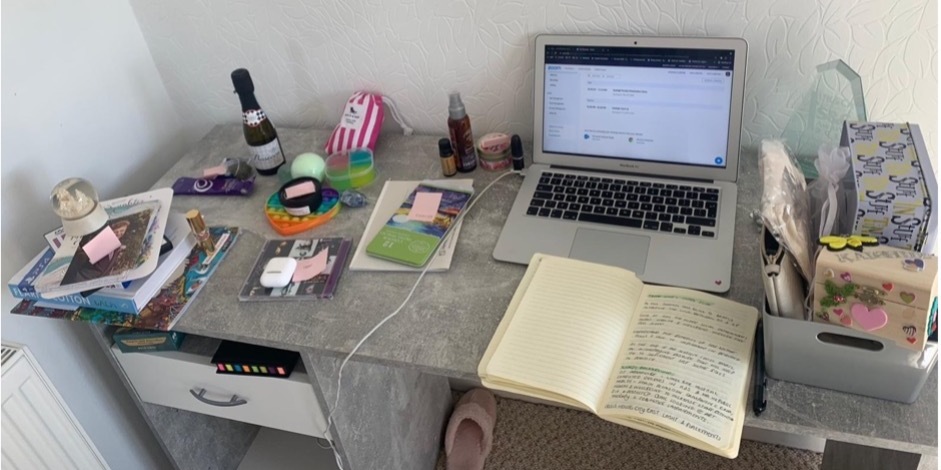Self Soothe Box Education - An Occupational Therapy Intervention for Social Prescribers
Written by Kayleigh Wain
During a role emerging placement within the Nottinghamshire Alliance Training Hub, an Occupational Therapy (OT) Degree Apprentice (Kayleigh Wain) provided education to Social Prescribing Link Workers (SPLWs) to implement within Primary Care Networks (PCNs).
1. Scoping the service
The intervention aimed to align with NATH’s core functions defined by the NHS Long Term Plan (NHS, 2019).
The aim was to provide education to the primary care workforce to support effective delivery of healthcare needs within the community.
2. Audience identification
Social Prescribing Link Workers (SPLWs) were identified to be the recipients of the intervention.
The 'SPLW Delivery Meeting' reported that they were struggling to cope and identify interventions to use in response to an increase in complex mental health referrals. SPLWs had received education on OT assessments, but had no current knowledge on OT interventions.
3. Intervention
SPLWs received OT based education to build upon their OT knowledge, and received a printable resource on:
Applying the Person-Environment-Occupation (PEO) model in practice.
The process on how and when to implement Self Soothe Boxes for patients experiencing anxiety and depression.
Recommendations of potential items to include relating to the 5 senses.
The benefits of Self Soothe Boxes to promote emotional regulation.
4. Relevance to occupational therapy practice
The education was prevalent due to OT being under-utilised in primary care (Lyons- Maris, 2019), with a focus on social prescribing to reduce pressures on general practices (Bradley & Scott, 2021). The lack of OT involvement highlights the prevalence of role emerging placements, to support link workers on how to address barriers to engagement (Thew, Bell & Flanagan, 2017), by linking meaningful activity to health (Garside, 2020). The impact of providing OT education and evidence base for social prescribing can develop and influence future practice of social prescribing (RCOT, 2020).
5. Delivery
Due to COVID-19, the education was delivered by a variety of methods including a face-to-face session and virtually via Teams.
A 7 minute presentation for 'Mental Health Week 2021' was delivered nationally during a social prescribing webinar via Teams live and was accessed by over 400 link workers.
6. Occupational therapy concepts
PEO Model: This model encompasses a client centred approach (Law et al.1996), by highlighting that the interaction of the person, environment and occupation facilitates participation. This framework was essential to discuss, due to it being a new criteria in the social prescribing competency framework. The promotion of these findings and strategies helps to overcome the barriers to engagement in meaningful activity (Connolly et al., 2019, Fieldhouse, Bryant & Creek, 2014).
Flow: It was encouraged that items in the box should be meaningful and personalised to the individual to increase occupational flow (Wright et al., 2014). Flow promotes an individual to be immersed in an activity, that allows them to escape their thoughts for a moment, and encourages safe coping strategies (Reid, 2011).
7. Evaluation
All SPLWs received a Google form to collate the effectiveness of the education, and whether they would apply Self Soothe Boxes in practice. In total 20 link workers completed the evaluation:
95% reported they wanted further OT education on interventions
95% felt that the Self Soothe Box education was engaging
100% reported they would implement Self Sooth Boxes in practice

8. Challenges and solutions
Due to COVID-19, this meant some education had to be virtual. To overcome this challenge, and ensure it was engaging a practice presentation was delivered to NATH employees to gain feedback to ensure it was stimulating and appropriate.
Link Workers had limited free time due to increase workloads. It was negotiated that education would last 30 minutes, and a step-by-step resource on implementing Self Soothe Boxes was disseminated via email to all Link Workers. This ensured that if Link Workers couldn’t attend, they would benefit from the resource.
9. Impact
"I have used the process already with a 24 year old woman with BPD and PTSD. It’s working already, thank you so much."
SPLW Team Leader
A key impact from the intervention was the local and national recognition on the value of OT input to support social prescribers to implement effective OT interventions within Primary Care Networks.
The evaluation results were sent to the Head of Social Prescribing in the local area, who agreed they would look into further OT education, and is keen for future OT students to have placements with social prescribers.
References
Bradley, G., & Scott, J. (2021). Social Prescribing Nomenclature, Occupational Therapy and the Theory of Institutional Work : Creating, Maintaining and Disrupting Medical Dominance. Occupational Therapy in Health Care, 1–14. https://doi.org/10.1080/07380577.2021.1926046
Connolly, D., Anderson, M., Colgan, M., Montgomery, J., Clarke, J., & Kinsella, M. (2019). The impact of a primary care stress management and wellbeing programme (RENEW) on occupational participation: A pilot study. The British Journal of Occupational Therapy, 82(2), 112–121. https://doi.org/10.1177/0308022618793323
Fieldhouse, J., Bryant, W., & Creek, J. (2014). Creek's occupational therapy and mental health. Edinburgh: Churchill Livingstone.
Garside, R. (2020). What approaches to social prescribing work, for whom, and in what circumstances? A realist reviews. Health & Social Care in the Community., 28(2), 309–324. https://doi.org/10.1111/hsc.12839
Law, M., Cooper, B., Strong, S., Stewart, D., Rigby, P., & Letts, L. (1996). The Person-Environment-Occupation Model: A Transactive Approach to Occupational Performance. Canadian Journal of Occupational Therapy (1939), 63(1), 9–23. https://doi.org/10.1177/000841749606300103
Lyon-Maris, J. (2019). Occupational therapy in primary care: exploring the role of occupational therapy from a primary care perspective. The British Journal of General Practice : the Journal of the Royal College of General Practitioners., 69(688), 575–576. https://doi.org/10.3399/bjgp19X706517
NHS (2019). NHS long term plan. Retrieved from: https://www.longtermplan.nhs.uk/
Reid, D. (2011). Mindfulness and Flow in Occupational Engagement: Presence in Doing. Canadian Journal of Occupational Therapy (1939), 78(1), 50–56. https://doi.org/10.2182/cjot.2011.78.1.7 Royal College of Occupational Therapists. (2020). Informed view: Social prescribing. London. Retrieved from: https://www.rcot.co.uk/node/2381
Thew, M., Bell, F., & Flanagan, E. (2017). Social prescribing: An emerging area for occupational therapy. The British Journal of Occupational Therapy, 80(9), 523–524. https://doi.org/10.1177/0308022617700905
Wright, J. J., Wright, S., Sadlo, G., & Stew, G. (2014). Exploring Optimal Experiences: A Reversal Theory Perspective of Flow and Occupational Science. Journal of Occupational Science, 21(2), 173–187. https://doi.org/10.1080/14427591.2012.713312
Share this post:



